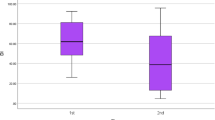Abstract
In the present study we evaluated the facial nerve latency test (FNLT) as a prognostic tool in cases of childhood Bell's palsy. Twenty-five children aged 4–14 years were studied. We divided our subjects into three groups according to duration of latency time (LT). Group A patients had an LT within the normal range, with average of 3.27 ms, group B a slightly prolonged LT averaging 5.7 ms, and group C a markedly prolonged LT averaging 10.5 ms. Analysis of the recovery index by group showed that group A patients experienced complete and quick recovery, while in group B 50% had complete but delayed recovery and 50% slightly impaired facial nerve function, and in group C 50% had slightly impaired function and 50% incomplete recovery. The more prolonged the LT, the worse the clinical results. The FNLT is thus a valuable prognostic tool in cases of Bell's palsy in childhood.
Similar content being viewed by others
References
Danielides V (1990) The contribution of electrodiagnostic tests in evaluation and location of damage of the facial nerve. Doctoral thesis, Ioannina, Greece
House JW (1983) Facial nerve grading system. Laryngoscope 93:1056–1069
Joachims HZ, Bialik V, Eliachar I (1980) Early diagnosis in Bell's palsy. Laryngoscope 90:1705–1708
Langworthy EP, Taverner D (1963) The prognosis in facial palsy. Brain 86:465
Seddan HJ (1943) Three types of nerve injury. Brain 66:237–288
Skevas A, Danielides V, Assimakopoulos D (1990) The role of the facial nerve latency test in prognosis of Bell's palsy. Laryngoscope, vol 100, no 10
Sunderland S (1978) Nerve and nerve injuries. Churchill-Livingstone, London, pp 88–89, 96–97, 133
Waylonis GW, Johnson EW (1964) Facial nerve conduction delay. Arch Phys Med Rehab 45:539
Author information
Authors and Affiliations
Rights and permissions
About this article
Cite this article
Danielides, V.G., Skevas, A.T., Panagopoulos, K. et al. Value of the facial nerve latency test in the prognosis of childhood Bell's palsy. Child's Nerv Syst 8, 126–128 (1992). https://doi.org/10.1007/BF00298266
Received:
Issue Date:
DOI: https://doi.org/10.1007/BF00298266



